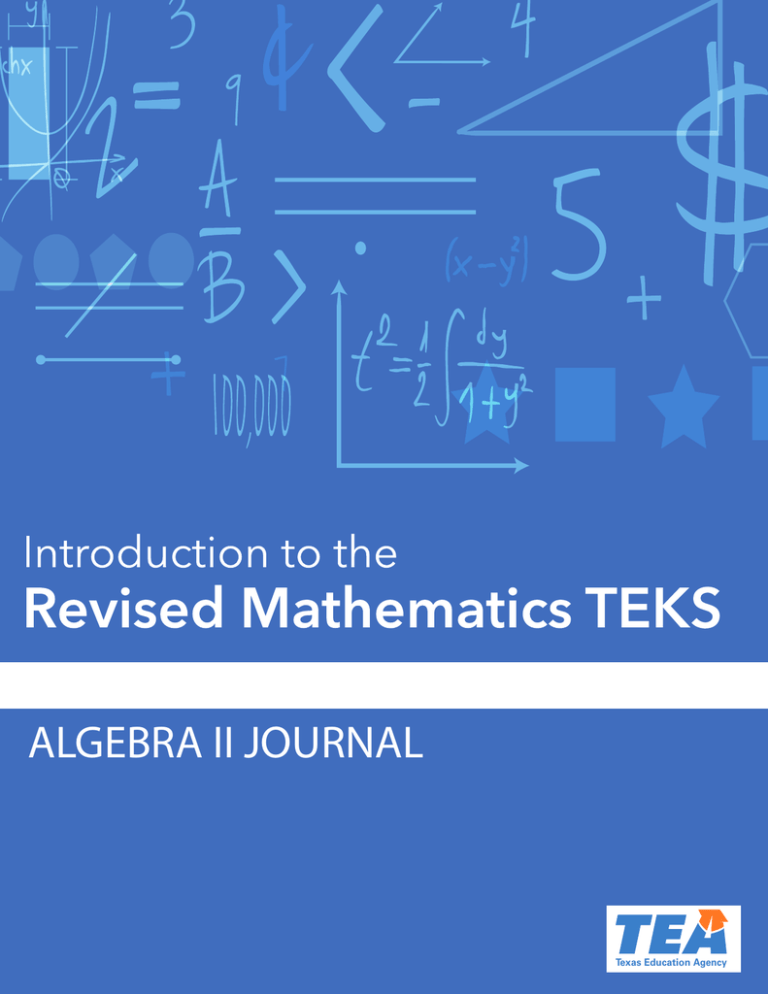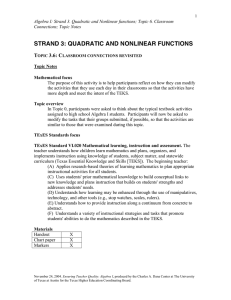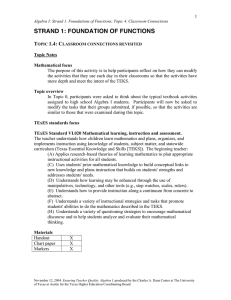
ALGEBRA II JOURNAL
Texas Education Agency
The materials are copyrighted (c) and trademarked (tm) as the property of the
Texas Education Agency (TEA) and may not be reproduced without the
express written permission of TEA, except under the following conditions:
Texas public school districts, charter schools, and Education Service
Centers may reproduce and use copies of the Materials and Related
Materials for the districts’ and schools’ educational use without
obtaining permission from TEA.
Residents of the state of Texas may reproduce and use copies of the
Materials and Related Materials for individual personal use only
without obtaining written permission of TEA.
Any portion reproduced must be reproduced in its entirety and remain
unedited, unaltered and unchanged in any way.
No monetary charge can be made for the reproduced materials or any
document containing them; however, a reasonable charge to cover
only the cost of reproduction and distribution may be charged.
Private entities or persons located in Texas that are not Texas public
school districts, Texas Education Service Centers, or Texas charter
schools or any entity, whether public or private, educational or noneducational, located outside the state of Texas MUST obtain written
approval from TEA and will be required to enter into a license agreement
that may involve the payment of a licensing fee or a royalty.
For information contact:
Office of Copyrights, Trademarks, License Agreements, and Royalties,
Texas Education Agency,
1701 N. Congress Ave., Austin, TX 78701-1494;
phone: 512-463-9041;
email: copyrights@tea.texas.gov.
©2015 Texas Education Agency All Rights Reserved 2015
©2015 Texas Education Agency. All Rights Reserved 2015
Introduction to the Revised Mathematics TEKS
Revised Mathematics TEKS Scavenger Hunt
Review the Revised Mathematics TEKS for Algebra I, Algebra II, and Geometry. Use them to answer the
following questions.
1. How many strands are in each content area? What are those strands?
Algebra I _____
Geometry _____
Algebra II _____
2. Examine the knowledge and skills statement for each of your strands. How are these statements
similar?
3. What is the significance of the mathematical process standards for each content area?
4. Choose one content area. I am examining ____________________________.
5. For the content area you identified, choose one strand. I am examining
______________________.
6. What similarities do you find among the student expectations in the strand you
identified?
7. Why might the student expectations have been grouped in this way?
©2015 Texas Education Agency. All Rights Reserved 2015
Introduction to the Revised Mathematics TEKS: Grades 9-12
Mathematical Process Standards 3-Word Summary
•
•
•
Read the 7 process standards.
Use 1, 2, or 3 words to summarize the main idea of each process standard.
Record your answers in your journal.
Mathematical Process Standards
The student uses mathematical processes to acquire and demonstrate
mathematical understanding.
1–2–3 Word Summary
(1)(A) The student is expected to apply mathematics to problems arising in
everyday life, society, and the workplace.
(1)(B) The student is expected to use a problem-solving model that
incorporates analyzing given information, formulating a plan or strategy,
determining a solution, justifying the solution, and evaluating the problemsolving process and the reasonableness of the solution.
(1)(C) The student is expected to select tools, including real objects,
manipulatives, paper and pencil, and technology as appropriate, and
techniques, including mental math, estimation, and number sense as
appropriate, to solve problems.
(1)(D) The student is expected to communicate mathematical ideas,
reasoning, and their implications using multiple representations, including
symbols, diagrams, graphs, and language as appropriate.
(1)(E) The student is expected to create and use representations to organize,
record, and communicate mathematical ideas.
(1)(F) The student is expected to analyze mathematical relationships to
connect and communicate mathematical ideas.
(1)(G) The student is expected to display, explain, and justify mathematical
ideas and arguments using precise mathematical language in written or oral
communication.
©2015 Texas Education Agency. All Rights Reserved 2015
Introduction to the Revised Mathematics TEKS: Grades 9-12
Integrating Student Expectations with Mathematical Process Standards
Questions for Consideration
•
What impact does the process
standard have on the content
student expectation?
•
What impact does the process
standard have on the way we
expect students to respond to
questions?
Content Area _________________________
Observations:
Reflection:
• What impact might integrating the mathematical process standards have on the way we expect students to
demonstrate their understanding?
©2015 Texas Education Agency. All Rights Reserved 2015
Introduction to the Revised Mathematics TEKS: Grades 9-12
Algebra II and the Mathematical Process Standards
Student Expectation
2A(4)(A) The student is expected to write the quadratic function given three specified points in the plane.
Write a quadratic function in standard form given f (3) =
0, f (−2) =
0, and f (0) =
−6.
Integrating the Student Expectation with a Mathematical Process Standard
2A(4)(A) The student is expected to write the quadratic function given three specified points in the plane.
2A(1)(B) The student is expected to use a problem-solving model that incorporates analyzing given
information, formulating a plan or strategy, determining a solution, justifying the solution, and
evaluating the problem-solving process and the reasonableness of the solution.
A soccer ball is kicked off the ground and reached its maximum height of 30 feet in the air after 2.5
seconds had elapsed. It hit the ground 2.5 seconds after reaching its maximum height. Determine how
much time elapsed while the ball was in the air 11 feet or more.
©2015 Texas Education Agency. All Rights Reserved 2015
Introduction to the Revised Mathematics TEKS: Grades 9-12
Amplifying an Instructional Task – Algebra II Example
Original Task
The student is expected to describe and analyze the relationship between a function and its inverse
(quadratic and square root, logarithmic and exponential), including the restriction(s) on domain, which will
restrict its range. 2A(2)(C)
For each function f ( x ) , determine f −1 ( x ) and state domain restrictions as necessary.
1.
f=
(x) 2 x + 3
2.
f (x) =
1
( x − 4)2 + 3, for x ≥ 4
2
©2015 Texas Education Agency. All Rights Reserved 2015
Introduction to the Revised Mathematics TEKS: Grades 9-12
Amplifying Instructional Tasks – Algebra II Example
Considerations for Brainstorming
Guiding Questions
Consider the revised
TEKS in the Original
Task
What main
concepts and/or
skills are involved
in this task?
Consider the related SEs
Consider the Context
What else might be explored or applied?
• Additional mathematical ideas from
related student expectations
• Process standards
• Grade level connections
Real-World Context
What else could be explored within this
context? What related ideas could be
added?
Consider the Student
What Tier I differentiation may be
needed to reach the student who is
• struggling,
• learning English, and/or
• advanced?
Is there a real-world context for this
idea?
What are related
concepts and/or
skills?
Mathematical context
Are there different starting points for
the problem?
Brainstorming
How else could the material be
presented?
Main Concepts
and/or Skills
Graph and write
the inverse of a
function using
notation such as
-1
f (x) 2A(2)(B)
Process Standards
• Process standards 2A(1)(A-G)
Content Standards
•
•
Related Concepts
and/or Skills
Multiple
representations
2A(1)(D)
•
•
Describe and analyze the relationship
between a function and its inverse
(quadratic and square root, logarithmic
and exponential), including the
restriction(s) on domain, which will
restrict its range. 2A(2)(C)
Use the composition of two functions,
including the necessary restrictions on
the domain, to determine if the functions
are inverses of each other. 2A(2)(D)
Write the quadratic function given three
specified points in the plane. 2A(4)(A)
Determine the effect on the graph of f(x)
= √x when f(x) is replaced by af(x), f(x) +
d, f(bx), and f(x - c) for specific positive
and negative values of a, b, c, and d.
2A(4)(C)
©2015 Texas Education Agency. All Rights Reserved 2015
Context
• How does the student thinking
differ if the graph is presented
first? Or the table?
• How do transformations of a
function affect the inverse of that
function?
•
What restricts the domain of the
inverse of a function?
Struggling
• Model the use of additional tools
(hands-on, pictures).
• Model the use of a graph and
transformations to determine key
attributes of a function.
Learning English
• Provide sentence stems and
frames.
• Provide opportunities to speak.
• Pre-teach vocabulary.
Advanced
• What does it mean for
-1
f(x)=f (x)?
Introduction to the Revised Mathematics TEKS: Grades 9-12
Amplifying an Instructional Task – Algebra II Example
Amplified Task
Task A
For each function f ( x ) , determine f −1 (x ) and state domain restrictions as necessary. Use the
composition of functions to verify the inverse function.
1. The quadratic function represented below with domain x ≥ 4:
2.
f ( x ) is the function g(x ) =
•
•
x
f (x)
5
3.5
7
7.5
8
11
x with the following transformations:
Vertically stretched by a factor of 2
Translated three units to the left
©2015 Texas Education Agency. All Rights Reserved 2015
Introduction to the Revised Mathematics TEKS: Grades 9-12
Task B (Scaffolded Task):
For each function f ( x ) , determine f −1 (x ) and state domain restrictions as necessary. Use the
composition of functions to verify the inverse function.
1. The quadratic function represented below with domain x ≥ 0:
x
f (x)
2
4
−2
1
6
6
f (x ) = _______________
f −1 (x ) = _______________
2.
f ( x ) is the function g(x ) =
•
•
x with the following transformations:
Vertically stretched by a factor of 2
Translated three units to the left
f (x ) = _______________
f −1 (x ) = _______________
Hint:
Which of the following
represents f ( x )?
f ( x ) = ag( x )
f ( x ) = g(bx )
f (=
x ) g( x − c)
f=
( x ) g( x ) + d
©2015 Texas Education Agency. All Rights Reserved 2015
Introduction to the Revised Mathematics TEKS: Grades 9-12
Task C (Scaffolded Task):
Determine which student in your pair will be partner A and which student will be partner B. Discuss the
following questions. The indicated partner will begin the discussion:
a. Partner A: What steps are needed to find the function to model a quadratic function
given a table of values?
b. Partner B: What are the steps to determine the inverse of a function?
Use the following conversation starters if needed.
Partner A
First, I would look for . . .
Then, I would . . .
Partner B
First, I would switch . . .
Next, I would solve . . .
For each function f ( x ) , determine f −1 (x ) and state domain restrictions as necessary. Use the
composition of functions to verify the inverse function.
1. The quadratic function represented below:
2.
f ( x ) is the function g(x ) =
•
•
x
f (x)
5
3.5
7
7.5
8
11
x with the following transformations:
Vertically stretched by a factor of 2
Translated three units to the left
©2015 Texas Education Agency. All Rights Reserved 2015
Introduction to the Revised Mathematics TEKS: Grades 9-12
Task D (Enriched Task):
For each function f ( x ) , determine f −1 (x ) and state domain restrictions as necessary. Use the
composition of functions to verify the inverse function.
1. The quadratic function represented below with domain x ≥ 0:
2.
f ( x ) is the function g(x ) =
•
•
x
f (x)
5
3.5
7
7.5
8
11
x with the following transformations:
Vertically stretched by a factor of 2
Translated three units to the left
3. For the functions in 1 and 2, determine when f ( x ) = f −1 ( x ).
©2015 Texas Education Agency. All Rights Reserved 2015
Introduction to the Revised Mathematics TEKS: Grades 9-12
A Vertical Look at Key Concepts and Procedures
Taking a Closer Look at Slope
What does the document tell us?
©2015 Texas Education Agency. All Rights Reserved 2015
What doesn’t the document tell us?
Introduction to the Revised Mathematics TEKS: Grades 9-12
A Vertical Look – Potential Perks and Pitfalls
Role
Teacher
Evaluator
Curriculum Leader
Instructional
Coach
Team Leader/
Department Chair
Parent
Perks
• Helps teachers to stay in their lane
• Helps buy back time by eliminating those ideas
that do not belong in the current grade level
• Helps to identify expected prerequisite knowledge
and skills
• Helps identify the key concepts and procedures
within the strands
• Helps to identify and anticipate gaps in students’
prerequisite knowledge to better target
interventions
• Helps identify the length of time students have
been working with a concept or procedure
• Helps to clarify if the instruction is on grade level
for classroom observations and documentation
• Helps guide conversations within and between
grade levels
• Helps facilitate movement and evaluation of
curriculum materials
• Helps target future professional development
needs for the district
• Helps guide conversations within and between
grade levels
• Helps facilitate movement and evaluation of
curriculum materials
• Helps target future professional development
needs for each teacher
• Helps guide conversations within and between
grade levels
• Helps facilitate movement and evaluation of
curriculum materials
• Helps to clarify if the instruction is on grade level
• Provides a concise look at what is to be covered
in a grade level
©2015 Texas Education Agency. All Rights Reserved 2015
Potential Pitfalls
•
•
•
•
This is NOT a curriculum
guide.
This does not provide the
specificity that the TEKS
provide.
This does not provide the
relative importance of
each key concept or
procedure.
This does not tell how to
teach the key concepts
and procedures.
Introduction to the Revised Mathematics TEKS: Grades 9-12
Side-by-Side Snap Shot Summary: Algebra II
Current Strand
1
Foundations for
Functions
2
Algebra and
Geometry
3
Quadratic and
Square Root
Functions
4
Rational
Functions
5
Exponential and
Logarithmic
Functions
Content that REMAINS
or is CLARIFIED
©2015 Texas Education Agency. All Rights Reserved 2015
Content that is NEW
Content that is MOVED
or DELETED
Introduction to the Revised Mathematics TEKS: Grades 9-12



